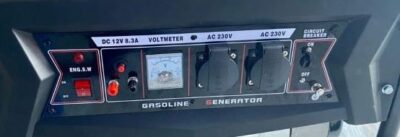This post contains affiliate links.
I love camping with a generator as it allows us to camp on sites or wild camps without worrying about heat or charging our devices.
But how can you ensure that your generator is safe?
Camping generators are an expensive valuable tool to use that will help make your trip more comfortable. However, care needs to be taken as there are safety hazards that you should be aware of to ensure that your experience is fun and without risk. Here are some safety tips for camping with a generator.
Follow these safety tips, so you and your family can enjoy a safe and hassle-free camping trip with a generator.
Learn about the importance of proper usage, maintenance, and safety precautions to ensure the safe operation of generators.
1 – Keep 1m clearance around the generator
For safety reasons, there should be at least a 1m / 3ft clear area around a fuel-sourced generator. The site should be cleared before the generator is started. Clearing the area of any loose foliage can help avoid a fire hazard. Especially if your generator overheats.
2 – 20 ft / 6m away from your tent or motorhome
The same rules apply to a fuel generator as an open flame fire pit or BBQ. A generator should be a minimum of 6m / 20 ft away from your tent or motorhome. Fumes from a generator are poisonous and known as carbon monoxide.
3 – Do not operate a fuel generator in your tent or motorhome
Under no circumstance should you use a generator inside a flammable tent or a motorhome. Diesel or petrol generators produce carbon monoxide fumes which are fatal if breathed in. It only takes 45 minutes for systems to show, which is a very short period of time. Symptoms include headache, nauseous and dizziness.
4 – Set up on solid-level ground
You should always set your generator up on solid, level ground for several reasons.
- Stability – Avoiding tipping over and damaging your generator
- Fuel efficiency – A unstable generator can cause fuel to lay unevenly in the tank. It can disrupt the generator and damage it
- Ventilation – If your generator tips, it is a potential fire risk. Not only does a generator need correct ventilation, but it can overheat and be a fire risk.
5 – Clean any fuel spillages
Always wipe any spillages when filling your generator with diesel or petrol. When generators work, they get hot, and fuel spillages are a fire hazard. As the generator increases in temperature, it can ignite fuel left on the surface or the ground around it.
6 – Understand how your generator works
Not all generators are the same. Although they have the basic principle of working, there will be differences. Please read the instruction manual before using it and test run before using it. Don’t wait until you need to use it urgently before trying it for the first time.
Understand how it works, where all parts are and how they work. Make your generator your best friend. Not only do you want to keep your generator reliable you don’t want it to let you want to be able to work safely.
7 – Regular safety checks
Follow the instruction manual fully, and understand what you must do to ensure your generator is safe. Always clear any debris, wipe fuel spillages and check for loose and damaged cables. These should be done before and after use.
There is a general rule of thumb for caring for your generator. Always check your generator after the first 5 hours of initial running and every 8 hours to clear air intake, fuel and oil levels. Our generator maintenance article will help you care for your generator and avoid any unnecessary damage or danger to life.
8 – Never enclose your generator whilst in use
Running a generator whilst it is working is dangerous as they produce fumes. The fumes are carbon monoxide which is undetectable by smell and is deadly. There should always be total airflow to allow fumes to escape efficiently.
It is not only due to exhaust fumes that the generator should be kept in a ventilated area. Allowing plenty of ventilation will keep your generator cool. They can overheat quickly and cause damage to your generator.
9 – Do not remove from the framework

Not all generators are inside of a metal frame. Generators that are enclosed in a metal frame should never be removed. The framework is part of the design and an important safety feature. It will stop your generator from tipping over, causing damage and reducing the fire risk. The framework provides a barrier against moving parts to stop touching these moving parts and avoid any clothing becoming trapped.
The framework will also help with noise pollution, as the design will incorporate moving parts and help to reduce vibration. Also, with the reduction of vibration, the generator will not move.
10 – Store fuel safely
Always ensure that the correct fuel is used in your generator.
- Use the correct fuel storage container and mark it clearly.
- Don’t leave fuel near the generator and away from other heat or ignition sources.
- Wipe any spilt fuel on your generator and clear it from surrounding areas.
- Check fuel lines are secure and that there are no splits.
- Never refuel when the generator is running, and allow the generator to cool.
11 – Allow the generator to cool before touching
Diesel and petrol generators’ main body gets hot whilst working and takes on average 15 minutes to cool. However, this timeframe may vary depending on the power of your generator. I always leave my generator 30 minutes before touching it. This is plenty of time, and I prefer to be over cautious than risk burning any part of my body.
12 – Keep clean
A dirty generator will reduce running efficiency. It can also cause corrosion, overheating and damage to parts such as the carburettor, fuel lines and air filters. Always clean and check before using, after and during usage.
Always remove any debris, as it can cause your generator to overheat and may cause a fire risk. Always follow the manufacturer’s instructions on maintenance frequency and replacement of parts such as air filters.
13 – Disconnect any electrical devices
There is a risk of electrocution if you disconnect electrical devices whilst it is working. Always turn off your generator if you need to unplug any electrical appliances. The generator creates electricity, and if you unplug a device, the electricity is still running to the plug. This can cause an electrical arch which can shock you.
14 – Do not modify the generator
Generators should never be modified. They are designed to ensure it works safely and correctly. The manufacturer, when designing, will consider wiring, and safety risks, including safety switches, fire risks and exhaust fumes.
Not only is the generator designed for your safety, but any modification will also affect the running, exhaust fumes and efficiency. Plus, any warranty will be voided. There is also a strong possibility that if any parts break, they may not be able to be easily repaired. Resulting in a generator that cannot be used due to broken parts or is unsafe.
15 – No overloading your generator
Too many electrical devices at once can cause your generator to overload and trip the circuit breakers.
- Fire hazard
- Cause damage to electrical equipment
- Reduce efficiency and life span of the generator
- Frustrating as you will need to reset once you have found what is tripping your generator
16 – Don’t let your generator get wet
Keeping your generator dry as a wet surface or leaving it in the rain can conduct electricity is essential.
- Moisture can cause the generator to malfunction, short-circuit, or even catch fire.
- Moisture can cause rust on the generator’s metal parts, weakening the structure and leading to leaks or other damage.
- Moisture can seep into the electrical components and cause corrosion or damage. Leading to electrical hazards or equipment failure, which is a risk to yourself and the environment.
17 – Electrical hook-up to your generator

Using an electrical hook-up mains supply unit to your generator provides additional protection. The electrical hook-up is 3 pin that connects to your generator with, on average, an extension lead of 15m or 30m that stretches to the inside of your tent. They have a main pole circuit breaker and RCD to distribute power more efficiently.
Electrical hook-up allows you to connect:
- Connect electrical devices safely in your tent or campervan.
- Charge mobiles with USB ports.
- Splash proof
- Provides a safe distance away from the working generator
- Extension cords should be rated for outdoor usage and have sufficient capacity to handle a generator’s wattage. (BS 5733 and applicable parts of BS 1363-2)
Related questions
How to prevent carbon monoxide poisoning when using a generator
Fuel-sourced or hybrid generators that require diesel and petrol (gasoline) to run need full ventilation when they are running. A generator should never run in an enclosed area or under any shelter where it cannot be ventilated efficiently.
This includes a tent, do not run or store your generator inside your tent. Not only do you risk carbon monoxide poisoning, but it is also a fire risk. Your generator should also be kept at least 1m from your tent to avoid fumes entering your tent during usage.
Another option is using a solar generator, which can be charged by sunlight or mains. However, this does defeat the object of having a solar generator.


